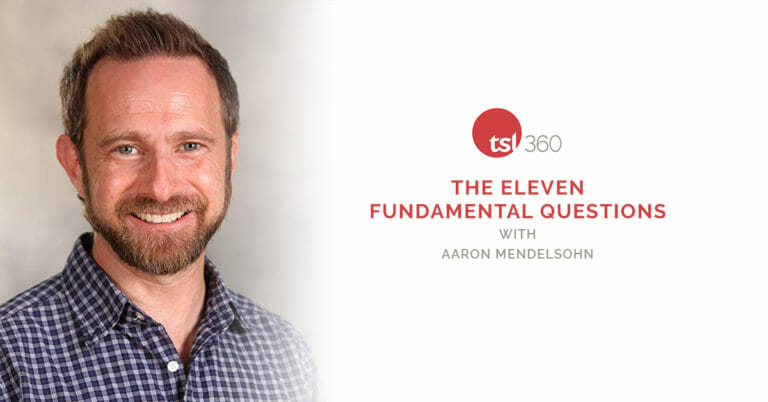By Valerie Kalfrin · February 15, 2019

Well, there are 11 fundamental questions — but we’re only going to tease you with 5 of them in this blog post. Screenwriter Aaron Mendelsohn never tires of asking the same handful of questions. Like a reporter asking who, what, where, when, why, and how, he’s learned that the answers build solid dramatic stories.
Mendelsohn, co-creator and co-writer of the massively successful Air Bud family movie franchise and a screenwriting professor and executive at the Writers Guild of America West, uncovered his go-to questions after battling the creative desire to write without an outline. “I dive into the script, and then I get lost as I enter into the second act because I don’t really know what my story is about,” he said in his recent TSL 360 video.
He eventually hit upon eleven questions that he asks himself consistently whenever starting a project. The process “forced me to think about these key story elements that almost all stories have,” he said.
Mendelsohn broke into screenwriting on the 1996 horror miniseries Kindred: The Embraced. More recently, he’s worked on the series Secret Diary of an American Cheerleader and co-wrote the 2017 Hallmark Channel movie Like Cats & Dogs. He’s also Secretary-Treasurer of the Writers Guild of America West.
Interviewing your story at the outset makes your writing time easier, he said. The process also preps you for the questions that agents, production companies, and other gatekeepers might have—and gives you a better chance of getting past them.
His main caveat is to accept the answers, even if they mean revisions. “A lot of times we’re sort of tempted to twist our answers so they fit the narrative that’s already in our head or that we’ve already written down,” Mendelsohn said. “Well, maybe what you had in your head wasn’t optimal. Maybe you need to really listen to the answers and change your story.”
We preview five of Mendelsohn’s eleven questions below. Catch the rest with a TSL 360 membership.
If you don’t already have a TSL 360 membership, be sure to join TSL 360 for a FREE 3-day trial membership! TSL 360 is the LARGEST screenwriting education content library where you can learn from the best in the biz, featuring dozens of masterclasses, deep-dive interviews and lectures from Academy Award-winning screenwriters, Emmy-winning TV writers, producers, agents, major studio executives – all in one place.
Even if your idea is complex, summarizing it in a logline forces you to distill it to its simplest form. “A lot of times you’ll find that you’ve got this rambling logline and that maybe you’ve got too much going on, your story’s too complex, or it just needs to be simplified,” Mendelsohn said.
A good logline covers not just the genre but the best attribute of your protagonist, a fatal flaw, an antagonistic force, and the stakes of the journey. Take this logline Mendelsohn created for 2010’s The King’s Speech: “In England on the brink of World War II, a goodhearted but insecure king who suffers from a debilitating stutter is forced to work with an eccentric speech therapist to deliver the speech that will save his kingdom.”
Download the screenplay for THE KING’S SPEECH here for free
Admittedly, this bakes two (ah, three) questions into one, but Mendelsohn considers character and desire intertwined. He finds it imperative to know your character’s history so that you can put the person who is tested the most at the center of your story. “I used to come up with these high concepts. More recently, I think more about interesting characters,” he said.
In the TV series Breaking Bad, chemistry teacher Walter White (Bryan Cranston) had the conscious desire to provide for his family after he was diagnosed with cancer—that’s what leads him into the drug business. “His unconscious desire, as we learn as the series progresses, is to reclaim his lost manhood,” Mendelsohn said.
A conscious desire and unconscious desire frequently oppose each other, as in the 2013 film Gravity. Astronaut Ryan Stone (Sandra Bullock) has to figure out how to return to Earth after an accident strands her in space, but losing her daughter before the film begins gives her a fatal flaw—little will to survive. She has to overcome not just the forces of nature but her own grief and defeatism, he said.
Download the screenplay for GRAVITY here for free
“I learned this one the hard way, where I’ve written a whole script, turned it in to my agent, and my agent said, ‘No, it’s really … it’s great. But there’s nothing at stake in the story.’ And I’m like, ‘Ah, you’re right,’” Mendelsohn said.
What does the central character or the world at large have to lose if this person doesn’t answer the call to action? If they fail to achieve their conscious or unconscious desires?
A TV series like The Walking Dead has the overarching stakes of being attacked by zombies at any time, but the surviving colonies and individual characters also have stakes that can set them in conflict with each other. Little Miss Sunshine (2006) has the main goal of getting to the pageant on time, but each family member has individual stakes: the dad feels weak, the marriage is rocky, the son wants to get into the army, and so on. “You can see how they rub against each other that way so a story can have a lot of stakes,” Mendelsohn said.
Download the screenplay for LITTLE MISS SUNSHINE here for free
This is your story’s theme or thesis—and the question often addressed by a critical test at the end of your story. In When Harry Met Sally… (1989), the central idea was whether men and women could be friends without a sexual relationship getting in the way, a setup that puts the main characters’ friendship at stake.
Be specific, and think of where you want the characters’ emotional journey to end. With a film like 2012’s The Avengers or 2014’s Guardians of the Galaxy, the theme is that the heroes only can triumph once they come together as a team.
“It doesn’t work to say, ‘It’s about fate and betrayal,’” Mendelsohn said. “That’s kind of the cheap way out. Really think about the unique, specific central idea for your story, and then try to see if you can test it in every scene.”
Download the screenplay for WHEN HARRY MET SALLY here for free
Your audience—even if it’s just readers, agents, and industry pros at first—has certain expectations for different genres. “They’re going to be looking for both things that honor the genre, those wonderful tropes and scares and laughs … but they’re also probably even more critically going to be looking for ways that you’re going to upend those genres and make them interesting.”
Let’s say you want to write about a river monster that’s found and brought to a test lab in Baltimore—clichéd, right? But what if the monster is the romantic hero, his love interest is a mute cleaning woman, and the antagonist—and real monster—is the strapping guy at the lab, as in 2017’s The Shape of Water?
“The Shape of Water honors the monster genre in so many ways,” Mendelsohn said, “but there’s also these wonderful subversions of the genre throughout the entire film. … You can always think of fresh ways to present new stuff.”
Download the screenplay for THE SHAPE OF WATER here for free
Don’t miss this video class – and hundreds of others – available to all members of TSL 360!
7 Strategies for ‘Producing People’ and Being a Great Producer with Kristen Murtha
8 Keys to Unlocking Hollywood Gatekeepers from Producer Sandra Leviton
4 Top Reps Reveal How to Get an Agent or Manager
5 Ways to Break In as a TV Writer
How to Write a Script That Sells: 4 Industry Perspectives

 Valerie Kalfrin is an award-winning crime journalist who now dives into fictional mayhem as an author (Quicklet on The Closer: Season 1), essayist, film critic, screenwriter, and emerging script consultant. She also writes for The Guardian, Bright Wall Dark Room, ScreenCraft, Hazlitt, Signature, and the blog for Final Draft, the top-rated screenwriting software used by the filmmaking industry. A member of Screenwriters of Tomorrow, she’s collaborated on short films and features, and she’s affiliated with the Tampa Bay Film Society. She lives in Florida. Find her online at valeriekalfrin.com.
Valerie Kalfrin is an award-winning crime journalist who now dives into fictional mayhem as an author (Quicklet on The Closer: Season 1), essayist, film critic, screenwriter, and emerging script consultant. She also writes for The Guardian, Bright Wall Dark Room, ScreenCraft, Hazlitt, Signature, and the blog for Final Draft, the top-rated screenwriting software used by the filmmaking industry. A member of Screenwriters of Tomorrow, she’s collaborated on short films and features, and she’s affiliated with the Tampa Bay Film Society. She lives in Florida. Find her online at valeriekalfrin.com.
For all the latest from The Script Lab, be sure to follow us on Twitter, Facebook, and Instagram.